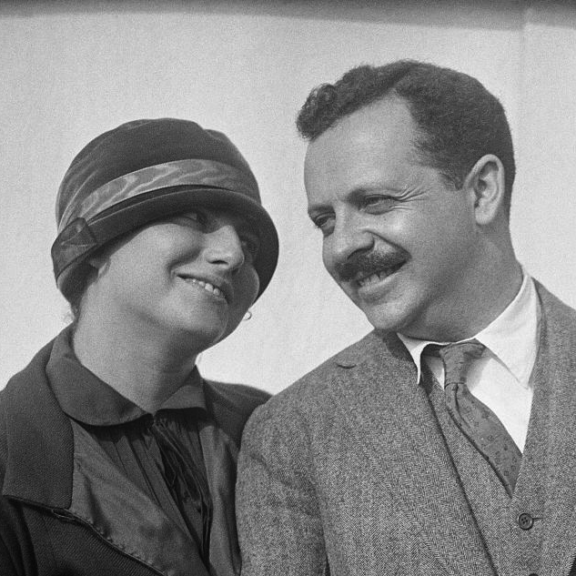Edward Bernays is considered “the father of PR.”
Bernays is credited with pioneering many techniques in the field of public relations. He was among the first to use psychology and other social sciences to design and implement public relations campaigns.
But Bernays was both celebrated and criticised.
Here we go:
The Father of PR: Edward Bernays
Edward Bernays (1891 – 1995) is considered the father of public relations (PR). His uncle was the famous psychologist Sigmund Freud, and Bernays, too, was interested in behavioural psychology. 1Edward Bernays. (2023, November 13). In Wikipedia. https://en.wikipedia.org/wiki/Edward_Bernays 2Olasky, M. (1984). Retrospective: Bernays’ doctrine of public opinion. Public Relations Review, 10, 3 – 12. https://doi.org/10.1016/S0363-8111(84)80088 – 0

Edward Bernays’ wife, Doris Fleischmann, was also a PR consultant who significantly contributed to the PR industry.
Bernays certainly was something of a character: His most famous book is titled “Propaganda” — in which he outlined how to manage the perceptions of crowds, much like modern Niccolo Machiavelli or Sun Tzu. 3Propaganda. (2023, November 10). In Wikipedia. https://en.wikipedia.org/wiki/Propaganda_(book)
“The conscious and intelligent manipulation of the organised habits and opinions of the masses is an important element in democratic society. Those who manipulate this unseen mechanism of society constitute an invisible government which is the true ruling power of our country.”
Source: Propaganda 4Bernays, E. L. (1928). Propaganda. New York, NY: Horace Liveright.
PR Case Study: Torches of Freedom
When helping Lucky Strike, Bernays realised that cigarette smoking was mostly a male habit. From a business perspective, there was a golden opportunity to add half the population to Lucky Strike’s list of potential customers.
No one had done this successfully, not because no one ever had that idea, but because it was a tough nut to crack. But Edward Bernays succeeded by tapping into another prevailing trend in society: The emancipation of women.
Bernays positioned cigarettes for women as “Torches of Freedom.” He placed the idea in articles, newspapers, celebrity endorsements, and events. He planted the public perception of women smoking not because it was enjoyable but as a symbol of female independence.
PR Case Study: Eggs and Bacon
Have you ever had eggs and bacon for breakfast at a hotel? Well, you can thank Bernays for that idea.
Another PR legend is how Bernays helped the farming industry convince people to eat more eggs and bacon. To do this, he wanted to change people’s perceptions of when it’s okay to eat eggs and bacon.
Bernays cooperated with food scientists to establish that eggs and bacon should be part of a healthy breakfast for every American. And to manifest this, he collaborated with chains of hotels to have them serve eggs and bacon for breakfast. 5Later in life, Bernays became a vegetarian and advocated for a meatless diet, which was unusual at the time, especially given his work promoting products like bacon.
Learn more: Edward Bernays — The Father of PR
Edward Bernays, Psychological Theories, and Mass Persuasion
Edward Bernays, often called the “father of public relations,” was highly influential in developing modern public relations and propaganda techniques. Born in 1891 in Vienna, Austria, Bernays was a nephew of Sigmund Freud, the famous psychoanalyst. His connection to Freud significantly influenced his work in public relations, as he applied psychological theories to the field. 6Edward Bernays was Sigmund Freud’s nephew. His mother was Freud’s sister, and his father was the brother of Freud’s wife. This familial connection certainly means that Bernays was aware of Freud’s … Continue reading
Edward Bernays’ wife, Doris Fleischmann, was also a PR consultant who significantly contributed to the PR industry. 7Doris Fleischman is not connected to the public relations agency FleishmanHillard. FleishmanHillard is a global PR agency founded in 1946 by Alfred Fleishman and Robert Hillard in St. Louis, … Continue reading
“Doris Fleischman’s work as a public relations consultant has received scant recognition, despite her significant contributions to the field and her equal partnership with her husband, Edward L. Bernays.”
Source: Journalism & Mass Communication Quarterly 8Henry, S. (1997). Anonymous In Her Own Name: Public Relations Pioneer Doris E. Fleischman. Journalism & Mass Communication Quarterly, 23, 50 – 62. https://doi.org/10.1080/00947679.1997.12062467
Bernays began his career in the U.S. by promoting World War I bonds and then worked in the Woodrow Wilson administration on the Committee on Public Information, a significant experience that shaped his understanding of mass persuasion. 9During World War I, Bernays worked for the U.S. Committee on Public Information (CPI), effectively serving as a propagandist. He applied techniques he later termed “engineering consent” to … Continue reading
Bernays authored several influential books, including “Crystallizing Public Opinion” (1923) and “Propaganda” (1928), in which he laid out his theories about public relations and the role of what he called the “engineering of consent” in a democratic society. 10Bernays, E. L. (1928). Propaganda. New York, NY: Horace Liveright. 11Bernays, E. L. (1923). Crystallizing public opinion. New York, NY: Boni and Liveright.
Bernays: Celebrated and Criticised
His work significantly influenced how corporations interact with the public, shaping modern marketing, advertising, and public relations strategies.
While Bernays is celebrated for his innovations, he is also criticised for manipulating public opinion and promoting corporate and political interests under the guise of objective information. His techniques have been scrutinised for ethical implications, especially in how they can sway public opinion without the public’s awareness of the manipulation.
One of his most notable campaigns was for the American Tobacco Company in the 1920s, where he helped to break the social taboo against women smoking in public. This campaign, known as the “Torches of Freedom,” is often cited as a classic example of using psychological principles in PR. But it’s also difficult to discern how successful the campaign was:
“The 1929 ‘Torches of Freedom’ March was staged, but the news media’s response to it was not nearly as celebratory as Bernays claimed, and its impact was likely never as extensive or persuasive as some have suggested.”
Source: American Journalism 12Murphree, V. (2015). Edward Bernays’s 1929 “Torches of Freedom” March: Myths and Historical Significance. American Journalism, 32, 258 — 281. https://doi.org/10.1080/08821127.2015.1064681
Bernays passed away in 1995, but his influence on advertising, marketing, and public relations remains profound and relevant in the understanding of media and communication in society. 13Bernays lived to be 103 years old, a notable lifespan that spanned significant historical periods and saw the evolution of the fields he influenced profoundly.

THANKS FOR READING.
Need PR help? Hire me here.

What should you study next?
Spin Academy | Online PR Courses

Influencing PR: Notable Contributors
It’s noted that the gender bias is apparent here. I’m currently researching a more balanced list.
Public Relations Contributors
Learn more: All Free PR Courses
💡 Subscribe and get a free ebook on how to get better PR.

Annotations
| 1 | Edward Bernays. (2023, November 13). In Wikipedia. https://en.wikipedia.org/wiki/Edward_Bernays |
|---|---|
| 2 | Olasky, M. (1984). Retrospective: Bernays’ doctrine of public opinion. Public Relations Review, 10, 3 – 12. https://doi.org/10.1016/S0363-8111(84)80088 – 0 |
| 3 | Propaganda. (2023, November 10). In Wikipedia. https://en.wikipedia.org/wiki/Propaganda_(book) |
| 4, 10 | Bernays, E. L. (1928). Propaganda. New York, NY: Horace Liveright. |
| 5 | Later in life, Bernays became a vegetarian and advocated for a meatless diet, which was unusual at the time, especially given his work promoting products like bacon. |
| 6 | Edward Bernays was Sigmund Freud’s nephew. His mother was Freud’s sister, and his father was the brother of Freud’s wife. This familial connection certainly means that Bernays was aware of Freud’s work and theories from an early stage. |
| 7 | Doris Fleischman is not connected to the public relations agency FleishmanHillard. FleishmanHillard is a global PR agency founded in 1946 by Alfred Fleishman and Robert Hillard in St. Louis, Missouri. The founders, Alfred Fleishman and Robert Hillard have no known connection to Doris Fleischman. The similarity in names is coincidental. |
| 8 | Henry, S. (1997). Anonymous In Her Own Name: Public Relations Pioneer Doris E. Fleischman. Journalism & Mass Communication Quarterly, 23, 50 – 62. https://doi.org/10.1080/00947679.1997.12062467 |
| 9 | During World War I, Bernays worked for the U.S. Committee on Public Information (CPI), effectively serving as a propagandist. He applied techniques he later termed “engineering consent” to promote the war effort, significantly influencing his later PR strategies. |
| 11 | Bernays, E. L. (1923). Crystallizing public opinion. New York, NY: Boni and Liveright. |
| 12 | Murphree, V. (2015). Edward Bernays’s 1929 “Torches of Freedom” March: Myths and Historical Significance. American Journalism, 32, 258 — 281. https://doi.org/10.1080/08821127.2015.1064681 |
| 13 | Bernays lived to be 103 years old, a notable lifespan that spanned significant historical periods and saw the evolution of the fields he influenced profoundly. |


